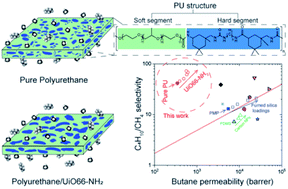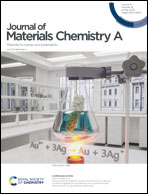Tuning the morphology of segmented block copolymers with Zr-MOF nanoparticles for durable and efficient hydrocarbon separation membranes†
Abstract
Microphase separation of block copolymers is a critical parameter to control the mechanical–physical properties. Zr-Metal–organic frameworks (MOFs) display high potential for the development of mixed matrix membranes. Here, the effect of UiO66 and amine-functionalized UiO66 (UiO66-NH2) nanocrystals on the phase separation and gas transport properties of polyurethane (PU) membranes is investigated. In addition to considerable gas adsorption on MOFs, tuning the phase separation of PU by the incorporation of UiO66-NH2 particles generates more accessible adsorption sites for gas molecules and increases the selectivity. The PU/UiO66-NH2 membrane exhibits high C4H10/CH4 selectivity (∼70), which is far beyond the separation performance of typical polymers (e.g. PDMS, PTMSP, etc.) for hydrocarbon separation. The increase in the phase separation is verified by FTIR, DSC and AFM measurements. C4H10 plasticization of the PU MMMs is significantly suppressed, and the mechanical properties are improved by more than 600% for PU/UiO66-NH2 composites. Additionally, the Maxwell model reliably predicts the transport properties of the membranes.



 Please wait while we load your content...
Please wait while we load your content...